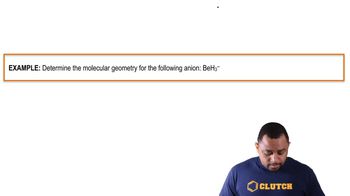Here are the essential concepts you must grasp in order to answer the question correctly.
VSEPR Theory
Valence Shell Electron Pair Repulsion (VSEPR) Theory is a model used to predict the geometry of molecules based on the repulsion between electron pairs in the valence shell of the central atom. According to VSEPR, electron pairs, whether bonding or lone pairs, will arrange themselves to minimize repulsion, leading to specific bond angles characteristic of different molecular shapes.
Recommended video:
Molecular Shapes and VSEPR
Trigonal Planar Geometry
Trigonal planar geometry occurs when a central atom is bonded to three other atoms and has no lone pairs of electrons. This arrangement results in bond angles of approximately 120 degrees, as the three bonding pairs spread out evenly in a plane to minimize repulsion, creating a flat, triangular shape.
Recommended video:
Resonance Structures
Resonance structures are different ways of drawing the same molecule that illustrate the delocalization of electrons. In the case of the borate ion (BO3^3-), resonance indicates that the actual structure is a hybrid of these forms, affecting the bond angles and lengths. This delocalization can influence the expected bond angles, as the electron density is spread over multiple bonds.
Recommended video:
 McMurry 8th Edition
McMurry 8th Edition Ch.8 - Covalent Compounds: Bonding Theories and Molecular Structure
Ch.8 - Covalent Compounds: Bonding Theories and Molecular Structure Problem 49
Problem 49 Verified step by step guidance
Verified step by step guidance


